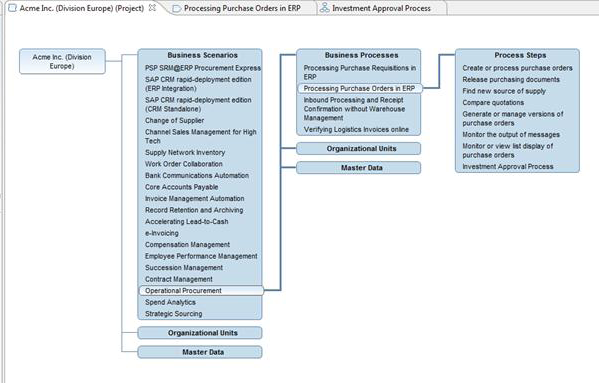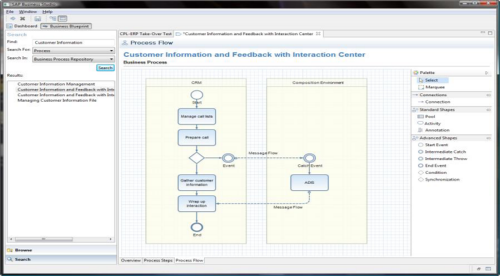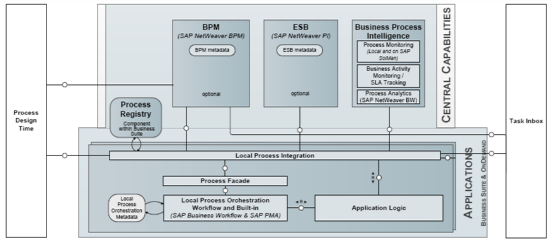At this week’s SAP Tech Ed conference in Las Vegas, BPM is definitely off the main track. The only other BPM analyst here that I recognized is Jim Sinur of Gartner. The keynote sessions were all about HANA, SAP’s new in-memory analytics platform that is the key to reinvigorating the entire SAP portfolio (at least the parts they still care about). HANA-enabled BPM won’t come until 2012, but it should provide a significant performance boost (process transactions per hour) as well as powerful real-time process analytics.
But it would be a mistake to say that SAP has not made significant progress in BPM. It has, but you had to skip the analyst sessions with the execs and go to the breakout sessions from the BPM product managers to hear about it. Those sessions were, on the whole, excellent, many of them hands-on with the tools. In that sense, Tech Ed is the mirror image of IBM Impact, where BPM sizzle was all over the keynotes, but almost no details were available in the breakouts.
SAP’s BPM strategy has always been unconventional, since most SAP process logic is embedded inside the Business Suite (ERP, CRM, etc.), not modeled in the NetWeaver Composition Environment. Where conventional BPM (such as NetWeaver BPM/PI) emphasizes BPMN-based activity flow, embedded processes involve transaction events where the order of occurrence at runtime is more flexible. SAP says both styles of process will always be needed, and their BPM portfolio aims at managing and monitoring them in combination. That general strategy has been in place for a couple years, but now it is less a hodgepodge of disparate products and much more of a coherent platform.
Key BPM features of version 7.31, available Q4, are BPMN-based NetWeaver Process Integration and Business Process Blueprints in SAP Solution Manager.
NetWeaver Process Integration (PI) is an application integration platform with an adapter framework (AEX). The new version abandons the BPEL-based CCBPM offering and replaces it with an ESB with embedded BPMN 2.0 engine. The new version is Java-only (I think the old PI supported both ABAP and Java, which added a lot of overhead). Unlike most BPMN-based development tools, which just model the orchestration within a single process, PI executes the collaboration logic – the message flows – as well. That is really important in SAP end-to-end solutions, where each SAP app is modeled in a separate pool (and NetWeaver BPM in its own pool as well), so the end-to-end process model involves a lot of messaging between them.
Actually, the link between these application processes is more than a simple message. It’s a process that runs on an ESB. PI 7.31 is the ESB and BPMN-based flow logic. (In a future implementation, it’s actually two processes: a stateless one that sends asynchronous requests and a stateful one that can aggregate the responses.) The tooling (Figure 1) is based on established enterprise integration patterns connecting a Sender entity to a Receiver, with BPMN tasks for things like Receiver split (identifying multiple receivers), Interface split, and mappings. The message flows in the model represent channel configurations using adapters.
Figure 1. PI process model. Source: SAP
Use of BPMN for the process logic on the integration bus creates a common modeling paradigm for PI and NetWeaver BPM. Essentially they become a single “seamless” product, NetWeaver Process Orchestration. This approach is more appealing to me than, say, IBM’s, where mediation flows are not BPMN-based.
The other important dimension of BPM at SAP is Business Process Blueprinting in SAP Solution Manager, introspecting Business Suite apps and exposing their embedded processes and steps for composition in NetWeaver BPM (Figure 2). Not only can the steps of the embedded process be visualized in BPMN, but user-defined exits in that process logic can trigger NetWeaver BPM processes that effectively customize the built-in process (Figure 3).
Figure 2. Blueprinting embedded process. Source: SAP
Figure 3. Blueprint in NetWeaver BPM. Source: SAP
Another benefit of Business Process Blueprinting is that the steps in embedded processes, Netweaver BPM/PI, and even external systems can be combined for process performance monitoring. For embedded processes, a component called the Process Facade (Figure 4) allows events in embedded processes to be correlated and logged on a common basis with NetWeaver for BAM and Process Analytics.
Figure 4. Integrated process monitoring architecture. Source: SAP
I haven’t yet mentioned Gravity, SAP’s answer to IBM Blueworks Live that runs in SAP Streamworks. Like Blueworks Live, Streamworks combines simple collaborative BPMN modeling in the cloud with ad hoc runtime collaboration. Unlike IBM, however, Streamworks collaboration tasks can be executed as part of a structured BPM process. I’m not sure if Gravity is part of 7.31 or not; the beta is still a bit shaky, in my opinion.
There’s more BPM to come from SAP post-7.31, including integration of complex event processing from Business Objects with BPM and, of course, HANA. So, even though the executives didn’t bother to talk about BPM, there’s a lot to like at SAP.




“The real thing shows you which BPMN 2.0 elements are the ones you need to know, and which you can ignore. The others do not” Now that is why students should sign up for this class. SO SO SO important.
Hi Bruce,
A very perceptive analysis. You’re fast becoming an SAP expert!
cheers Hans
Indeed a very objective opinion about the good things from Germany;-). Greetings from Holland.
[…] Details Tweet Posted by admin on Thursday, August 16, 2012, at 09:42. Filed under BPM. Follow any responses to this post with its comments RSS feed. You can post a comment or trackback from your blog. […]